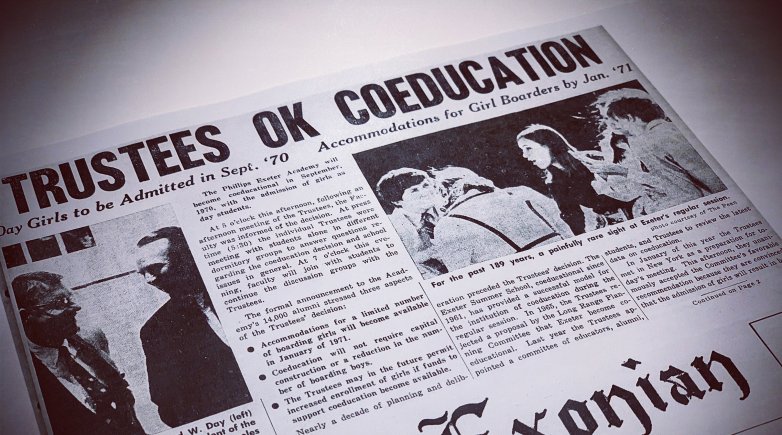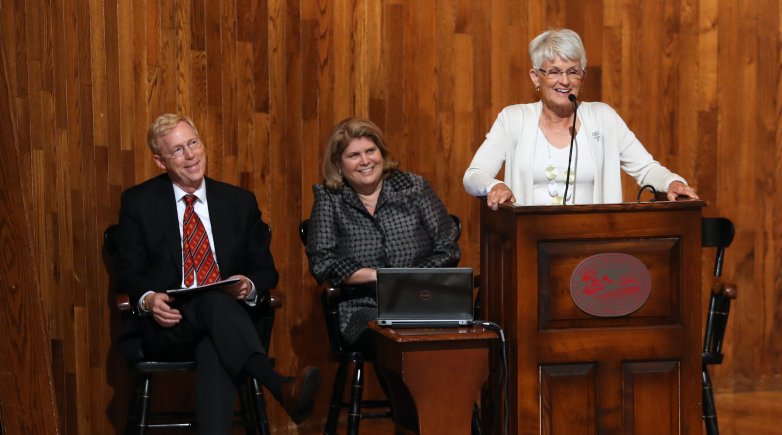'A tremendous step forward'
50 years ago, Exeter's Trustees voted in favor of coeducation.
The Exonian editors held the presses in time to report the historic decision in the day's edition.
On Feb. 27, 1970, a Friday, Exeter’s Board of Trustees gathered on campus to do Academy business. Finances and future construction were on the agenda, but their collective attention focused on the top of the list. The matter? Coeducation.
For most of two centuries, Phillips Exeter Academy had lived up to only half of its noble mission to educate “youth from every quarter.” Now, 16 trustees had assembled to remedy that. Their unanimous vote to open the school’s doors to girls was announced to alumni, faculty and the student body shortly after 5 p.m. by Trustee President Frederick “Bill” Andres ’25 and Principal Richard Day. Immediately after the announcement, trustees fanned out to dorm common rooms to meet with students and discuss what the future would look like.
Ira Fink ’71, managing editor of The Exonian, summarized the prevailing sentiment of the day in the pages of the newspaper: “We have made a tremendous step forward.”
The momentous decision set Exeter on a new, better path, blazed by the 39 day students who entered that September and by the thousands of girls who have since followed in their footsteps. Over the next 18 months, the Academy will reflect on the past 50 years, appreciate how this seminal moment forever changed Exeter and hear from those who lived history as it happened.
A long road
The Trustees’ vote was hailed as a new beginning, but it also marked the end of a drawn-out debate at the Academy. Coeducation had been under consideration for a decade. Exeter’s Summer School, sometimes seen as a test kitchen for the Academy, began admitting girls with success in 1961. Four years later, a faculty-led planning committee recommended that Exeter admit up to 250 girls in grades 11 and 12, stating in its report to the principal and Trustees that “if they were founding a boarding school today, it would be coeducational.”
That recommendation was rejected. Day, in announcing the decision in December 1965, voiced support instead for the idea of “coordinate education” — separate but adjacent schools for boys and girls — and expressed his desire for “an independent girls boarding school down the road” that might affiliate with the Academy. Milton Academy had operated under a coordinate structure, and a similar system had governed Mount Hermon and Northfield schools for a century.

In a news conference, Day noted of the Trustees’ decision to shelve coeducation: “This does not mean never, but only for the foreseeable future.” The future wasn’t far off, as it turns out. In 1967, a survey of the senior class, faculty and alumni was conducted around several key topics of concern at the Academy. On the issue of coeducation, the findings showed overwhelming support among students (88 percent) and faculty (77 percent). Alumni were divided, generally by year of graduation. Pre-World War II graduates preferred the status quo; but those who had graduated in the 20 years immediately prior to the survey were strongly in favor of coeducation.
The survey findings were printed in the winter 1969 issue of The Bulletin just days after Yale and Princeton universities announced their intentions to admit women in the coming fall. A movement was on. A new trustee-appointed committee was formed to again study the issue at Exeter. In the fall of 1969 that committee produced a familiar recommendation: Admit girls.
“It would not be the tradition of this school to wait until everybody else had done it and then say it was the thing to do,” said one committee member.
Added an 11th-grade boy serving as a student representative on the committee: “As for me, I know I like girls a lot.
'Decisive action'
Ahead of the Trustees’ visit in early 1970, the Student Council urged them to “take decisive action” to bring coeducation to Exeter. A steady drumbeat of student sup-port reverberated throughout the opinion pages of The Exonian, culminating in an editorial printed two days ahead of the historic Trustees meeting:
“Perhaps there are other Exonians who can see reasons for postponing or abandoning coeducation. We cannot. Coeducation at Exeter is one of the few issues around which unanimous student support has arisen. We are hard put to understand the presumptions — camaraderie, cold showers, concentration — which dictate that Exeter should remain a monastic community. We urge the Trustees to move forward as rapidly as possible towards transforming Exeter into a balanced coeducational school.”
The vote of the Trustees was unanimous. The response among alumni was less so. To some, it surely was no coincidence that The New York Times’ story of the decision ran on the newspaper’s obituary page. Paul Sadler ’45, then the editor of The Exeter Bulletin, wrote about the feedback in the spring 1970 issue: “It would be something less than candid to report that all reactions have been favorable.”
Sadler then added: “Surely, the real test will be in a few years as the performance of the girls is known. I, for one, feel they will contribute greatly to the school and I shall be glad to see them here.”



